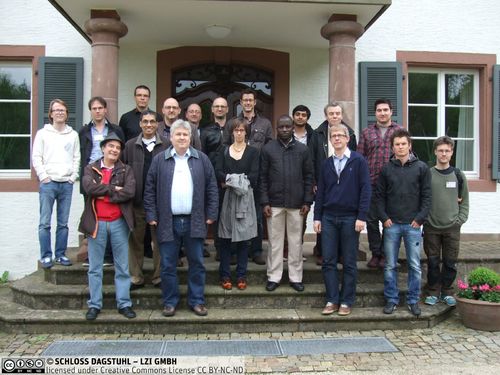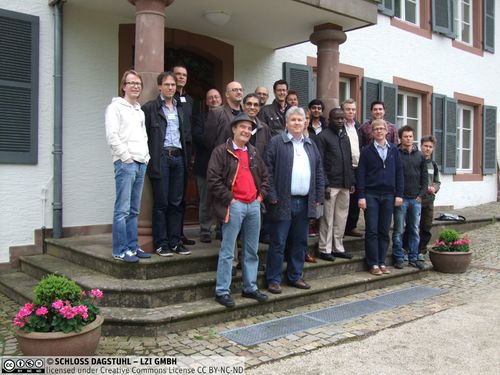Dagstuhl-Seminar 13212
Computational Methods Aiding Early-Stage Drug Design
( 19. May – 24. May, 2013 )
Permalink
Organisatoren
- Andreas Bender (University of Cambridge, GB)
- Hinrich Göhlmann (Janssen Pharmaceutica - Beerse, BE)
- Sepp Hochreiter (Universität Linz, AT)
- Ziv Shkedy (Hasselt University - Diepenbeek, BE)
Kontakt
- Annette Beyer (für administrative Fragen)
Programm
The seminar focuses on computer science applications in drug design. Currently, the pharmaceutical industry faces a large percentage of compounds that fail to reach the market. To reduce the risk of such failures, modern molecular biology technologies together with computational "in silico" techniques support decision-making in the early stages of drug discovery. Drug designers interrelate and interpret transcriptomic, genetic, proteomic, meta-bolomic, and assay data and, thereby, complement established methods in computational chemistry that rely on chemical structures. As computational tools are emerging as key technologies in drug design, there is a need for integrating knowledge and experiences from the fields of bioinformatics, chemo-informatics, machine learning, and statistics into the area of drug design.
In a first step of early drug design, compounds that seem promising to become drugs are selected for subsequent development. Such compounds are selected by two main approaches. (I) Structure-based drug design is based on predicting which compound binds to a particular target. (II) The current practice in many pharmaceutical companies is to apply ligand-based drug design, i.e. to screen their huge compound libraries for possible drug candidates. Ligand-based drug design often uses "analoging" to predict the activity of compounds by means of computational models. Analoging uses pharmacophores (target-specific functional groups) and structure-activity relationship (QSAR) models to represent the relationship between properties of a compound and its biological activity. In subsequent steps, selected compounds are optimized or successful drugs repurposed that is applied to new diseases using bioassays and ‘omics data. For all these steps computational tools are essential.
In this seminar computational methods for following drug design steps are reviewed:
- Compound filtering: chemical compounds are filtered based on (predicted) criteria like solubility, permeability, and (non-)toxicity.
- Compound selection: selection of compounds that have a (predicted) desired effect based on phenotypic screens or disease-specific bioassays.
- Compound effects identification: from bioassays and 'omics (e.g. gene expression) data on-target and on-target compound effects are identified.
- Compound optimization: modifications of compounds such that on-target effects are increase and on-target effects decreased.
Topics of the seminar include, but are not restricted to:
- Identifying relations between chemical structure and bioassays or 'omics data: supervised methods like classification and regression and unsupervised methods.
- Reduction of high dimensional data: unsupervised methods like (bi-)clustering, factor and component analysis, feature selection, projection, generative modeling.
- Representation of chemical structures: (a) explicitly by a vector of characteristics, e.g. by fingerprints or (b) implicitly by its similarity to other molecules, e.g. by kernels.
- Modeling of the interaction between a compound and a target: docking approaches and molecular dynamics simulations.
Besides discussing scientific findings enabled by computational approaches, the seminar successfully stimulated discussions between scientists from different disciplines and provided an exceptional opportunity to create mutual understanding of the various challenges and opportunities. It created understanding for technical terms and concepts and served as a catalyst to explore new ideas.
As a concrete example, it challenged the feasibility of utilizing chemical structure information for identifying correlations with biological data. Rather than attempting to define a most suitable way of translating chemical structure information into computer understandable form (e.g., via fingerprinting algorithms such as ECFP), the notion of utilizing functional readouts such as gene expression profiles was favored for prioritizing candidate drugs that demonstrate a favorable balance of desired and undesired compound effects.
 Andreas Bender, Hinrich Göhlmann, Sepp Hochreiter, and Ziv Shkedy
Andreas Bender, Hinrich Göhlmann, Sepp Hochreiter, and Ziv Shkedy
- Dhammika Amaratunga (Johnson & Johnson, US) [dblp]
- Andreas Bender (University of Cambridge, GB) [dblp]
- Ulrich Bodenhofer (Universität Linz, AT) [dblp]
- Chas Bountra (University of Oxford, GB)
- Javier Cabrera (Rutgers University - Piscataway, US) [dblp]
- Aakash Chavan Ravindranath (University of Cambridge, GB)
- Jelle J. Goeman (Leiden University Medical Center, NL) [dblp]
- Hinrich Göhlmann (Janssen Pharmaceutica - Beerse, BE) [dblp]
- Sepp Hochreiter (Universität Linz, AT) [dblp]
- Wolfgang Huber (EMBL Heidelberg, DE) [dblp]
- Murat Iskar (EMBL Heidelberg, DE) [dblp]
- Adetayo Kasim (Durham University, GB) [dblp]
- Samuel Kaski (Aalto University, FI) [dblp]
- Günter Klambauer (Universität Linz, AT) [dblp]
- Leo Lahti (Wageningen University, NL) [dblp]
- Justin Lamb (Genometry Inc - Cambridge, US)
- Johannes Mohr (TU Berlin, DE) [dblp]
- Gianluca Pollastri (University College Dublin, IE) [dblp]
- Ziv Shkedy (Hasselt University - Diepenbeek, BE) [dblp]
- Willem Talloen (Janssen Pharmaceutica - Beerse, BE) [dblp]
- Oswaldo Trelles (University of Malaga, ES) [dblp]
- Bie Verbist (Ghent University, BE) [dblp]
- Jörg Kurt Wegner (Janssen Pharmaceutica - Beerse, BE) [dblp]
Klassifikation
- bioinformatics
Schlagworte
- bioinformatics
- chemoinformatics
- machine learning
- statistics
- interdisciplinary applications



 Creative Commons BY 3.0 Unported license
Creative Commons BY 3.0 Unported license
